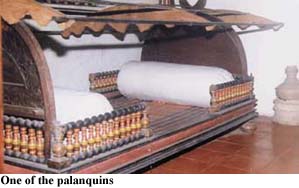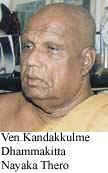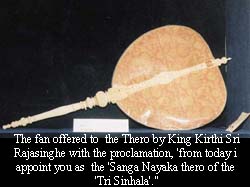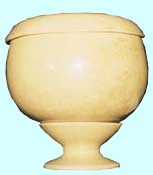 |
 13th June 1999 |
Front Page| |
An impressive museum in the Malwatte temple tells the story of the last 'Sangaraja' or the king of the monksHistory in a templeBy Chamintha Thilakarathna
The history of the title dates back to a time when kings influenced by foreign rulers were determined to wipe out Buddhism and the order of monks in the island during the reign of Sri Wijeya Rajasinghe (1739-1747). Hundreds of monks were assaulted and killed while others known as pseudo-priests (Ganninansela) opted to lead a mundane life casting off their religious beliefs to survive.
The task was not easy but the Thero was convinced that the lifeblood of the Sasana was discipline and monks who had received higher ordination should hold sway in the Buddhist order. Thus he sought the patronage of Kirthi Sri Rajasinghe (1747-1780) and also members of his association to bring to Sri Lanka, Buddhist monks who had received higher ordination. The Thero was supported in his efforts by Mohottala of Wilbagedara who facing great dangers at sea, journeyed to Siam to bring back with him monks who could help in achieving this aim. Impressed by the heroism of Ven. Sri Saranankara Thero, Upali, the Siamese priest trained him for higher ordination. Later he was declared Chief Sanga Nayaka or 'Sangaraja' of the island.And here, centuries later, lie his tools, his writings, and every item he used in his humble little room as the last 'Sangaraja' of the island.
Among the exhibits is a fan offered to the Thero by King Kirthi Sri Rajasinghe with the proclamation, "from today I appoint you as the 'Sanaga Nayaka thero' of the 'Tri Sinhala'." The fan has precious stones embedded in ivory.
In addition to the alphabet written on ola leaves, there are letters in six languages of which the Thero had ample knowledge. Also letters sent to the king of Siam through ambassadors and to Siamese monks requesting the granting of 'Upasampada' or higher order. Despite many stories of the use of the palanquin (dolawa), it is rarely that one comes across different types of 'dolawa' used by royalty and monks. In the museum one can find two expertly crafted examples decorated in red, green and white. The royal palanquin, belonging to the king, was later used by the Sangaraja Thero, and it is in this that he was brought back from exile to the palace. Another used by monks of a lesser order also has lovely carvings. Inside each are circular cushions on which the monks reclined while riding. It is said that they travelled lying down and not seated. The heavy vehicle lifted by strong bamboo poles supported by six strong men has a low roof made of cloth. The three types are 'Randoli'_for carrying ornaments of the gods, ' Pallakkiya', the palanquin for monks, and the 'dolawa', the palanquin for queens. Gold threaded robes and ancient inscriptions, also certificates given by the Governors are found in the museum. Most of the writings are accompanied by colourful drawings. Among its greatest treasures is the book on 'Path of Purification'. At the beginning and end are colourful illustrations of the 24 assurances by the 24 early Buddhas. The middle section contains the full path of purification handwritten by many monks, including Sri Saranankara Thero. The paper on which this is written has been gifted to King Kirthi Sri Rajasinghe by a Dutch Governor to be handed over to the 'Sangaraja'. "This is one of the greatest treasures in the museum. There are also many writings of Jathaka stories and pirith written by the Thero. And we believe that if it was not for the Thero they would not have survived for so long," said Ven.Kandakkulme Dhammakittha Nayaka Thero. The majestic looking museum inside the temple with its eighteenth century wood carvings is in itself breathtaking. There are here many accessories of the Kandyan era that tell a story of their own, of a society's life and customs. One such example is the coconut-shell spoon. Unlike those in use today, these spoons are longer and have the full coconut shell attached with only a small opening to take in water. The museum has its wealth of historical detail. But its director says that paltry assistance from the government has made maintenance a tough task. |
||
 |
Front Page| News/Comment| Editorial/Opinion| Business| Sports | Mirror Magazine |
|
 |
Please send your comments and suggestions on this web site to |
|
 A
wealth of historical detail awaits those who venture through long, winding
corridors of the Malwatta temple in Kandy to the museum that lies within.
The'Weliwita Saranankara Sangaraja Museum' houses artefacts of the last
'Sangaraja' or the king of the monks, a title bestowed by King Kirthi Sri
Rajasinghe.
A
wealth of historical detail awaits those who venture through long, winding
corridors of the Malwatta temple in Kandy to the museum that lies within.
The'Weliwita Saranankara Sangaraja Museum' houses artefacts of the last
'Sangaraja' or the king of the monks, a title bestowed by King Kirthi Sri
Rajasinghe.  They
patronised occult sciences to help people in their worldly activities.
These are recorded as times when values were fast disintegrating and the
'Dhamma' suffered serious setbacks. It was during this turbulent period
that Ven. Weliwita Sri Saranankara Thero undertook to restore Buddhism
in the island.
They
patronised occult sciences to help people in their worldly activities.
These are recorded as times when values were fast disintegrating and the
'Dhamma' suffered serious setbacks. It was during this turbulent period
that Ven. Weliwita Sri Saranankara Thero undertook to restore Buddhism
in the island.  "It
was the Venerable Thero who was known to have formulated the first Sinhalese
alphabet and written it down," says the Director of the Museum, Ven.
Kandakkulame Dhammakitthi Nayaka Thero.
"It
was the Venerable Thero who was known to have formulated the first Sinhalese
alphabet and written it down," says the Director of the Museum, Ven.
Kandakkulame Dhammakitthi Nayaka Thero. Also
on display is the large alms bowl of the Thero made of Siamese clay and
gifted to him by Upali.
Also
on display is the large alms bowl of the Thero made of Siamese clay and
gifted to him by Upali.